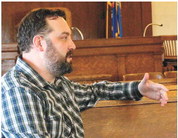Bank chief says banking in Wisconsin remains safe, secure


In the wake of government regulators last week seizing California-based Silicon Valley Bank (SVB) and the federal government taking swift action to guarantee depositors will be covered, local banking leaders are urging people to remain calm and assure them that their deposits are safe.
According to Nathan Quinnell, president of Prevail Bank, the circumstances that led to the SVB’s failure are simply not present in Wisconsin. He explained that SVB’s depositor base was not very diverse, being concentrated in tech industries which are cash-heavy with funds from venture capital firms.
By comparison, Quinnell said community banks, such as Prevail, have a wider, and more diverse portfolio of clients including small businesses, residential, and municipal deposits which individually are much smaller than the amounts involved with the SVB failure.
Deposits are federally insured up to $250,000 per individual, but in the case of SVB, less than 10% of the deposits were insured due to their size.
One of the major issues for SVB was in its rapid growth going from a $50 billion bank to a $200 billion bank in 18 months. Such a level of growth would be near impossible in Wisconsin without regulators raising red flags over liquidity and concentration of risk concerns. He said other than through merger acquisitions, growth rates among Wisconsin banks are typically in the three to five and seven percent range. By comparison, SVB quadrupled in size in a short period of time.
When banks get deposits, they turn around and match them with investments in order to gain a rate of return, which is used to pay interest on things like CDs or other deposits. These are typically a mixture of shorter and longer-term investments. Banks must use care to ensure they have access to cash to cover large withdrawals.
Liquidity is the ability of the financial institution to have cash on hand to cover depositors needs. Quinnell explained that community banks stay very liquid. He noted that in addition to the cash on hand banks such as Prevail have the established lines of credit to access hundred of millions of dollars in funds if needed.
In contrast, SVB was in a liquidity situation and depositors became fearful that their money would not be safe there and began to withdraw large amounts in a short period of time. This led to escalating liquidity issues and panic among depositors.
Quinnell assured members of the public that banks are safe for their deposits. He said the FDIC protection, which is insurance all banks pay into, protect investors and that there are other methods of assurance for larger deposits including letters of credit such as would be used for municipal deposits.
Quinnell’s words were echoed by the Wisconsin Bankers Association (WBA).
“The public can rest assured that the banking system overall and Wisconsin banks are safe, sound, and resilient. Wisconsin banks do not operate in the manner that caused the failure of Silicon Valley Bank in Santa Clara, California and Signature Bank in New York, New York. The customer base of Wisconsin banks is much more diversified and the overall balance sheet management of Wisconsin banks is significantly different. Regulators acted swiftly and decisively, which protected customers of the failed banks and prevented further pain across the banking system. As recent data from the Federal Deposit Insurance Corporation show, Wisconsin banks are well capitalized and remain on solid footing. Consumers can remain at ease knowing that their money is safe in an FDIC-insured bank in Wisconsin,” said WBA President and CEO Rose Oswald Poels.
Quinnell praised the quick action by the Federal government to prevent a panic from spreading.
“They did what they needed to do,” Quinnell said. Quinnell encourages people with questions to contact their local financial institution and to talk with representatives there about their concerns.
“As community banks, in general, we are here to help,” Quinnell said, encouraging depositors, both large and small to work with financial institutions in ensuring funds remain safe.






